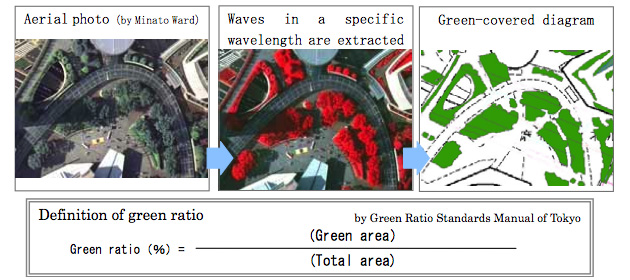Mori Building Co., Ltd. recently conducted a survey of the "green ratio" of its major development projects. The results showed that the greenery of ARK Hills (in Akasaka, Minato ward) increased 1.6 times, which is 0.71 ha (the equivalent of 27 tennis courts) over the past 16 years.
Urban development to coexist with nature
Adopting the "Vertical Garden City" as its redevelopment philosophy, one of the primary missions of Mori Building is to build environmentally friendly urban areas rich in greenery. The company has been proactively planting greenery in open spaces, generated by grouping buildings together, and also on rooftops. ARK Hills was established in 1986 as the first massive redevelopment project by a private company in Japan. This site pioneered the coexistence of urban and nature with its urban vegetation and nurtured ecosystem in its seven gardens, called "ARC Gardens".
Mori Building studied the growth of plants and trees at ARK Hills in its "green ratio" survey and found that the area of greenery in 1990 was 1.15 ha (the ratio of green coverage was 23.3%) and that it increased to 1.86 ha (37.5%) in 2006. This result shows that plants have been growing steadily for years. It is believed that this increase is due to the depth and arrangement of tree planting, the creation of rooftop gardens which allow over 20 meter high trees to grow, and the use of techniques and knowledge acquired over the company's long experience as a pioneer of urban vegetation.
■ARK Garden of Suntory Hall's rooftop
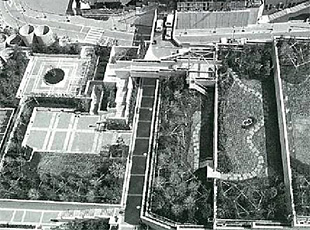
At the completion of construction
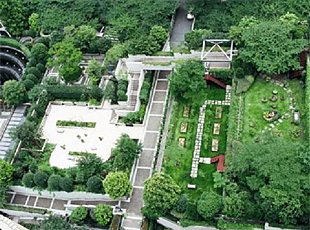
At present
Greenery of ARK Hills increased 1.6 times, 0.71 ha (27 tennis courts)
The "green ratio" survey was conducted using orthophotos. The photos show a strong light source which is caused by plants reflecting a specific wavelength. Using aerial photos taken every 5 years, the growth of plants at ARC Hills was surveyed and it was found that the area of green in 1990 was 1.15 ha (the ratio of green coverage was 23.3%) and that it increased to 1.86 ha (37.5%) in 2006. This shows that the plants have been growing steadily for years.
* Digital orthophotos provide high-precision images with less distortion. They are created by placing aerial photos on top of a map or GIS. (Refer to page 4)
■Change in green area and green ratio of ARK Hills
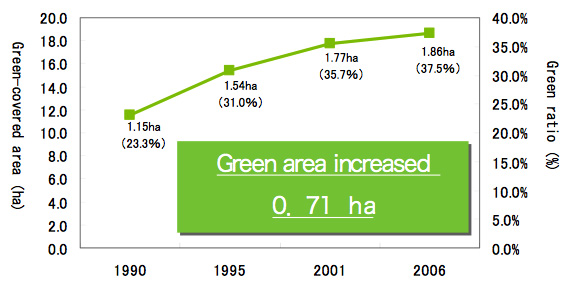
■ARK Hills covered by expansion of greenery
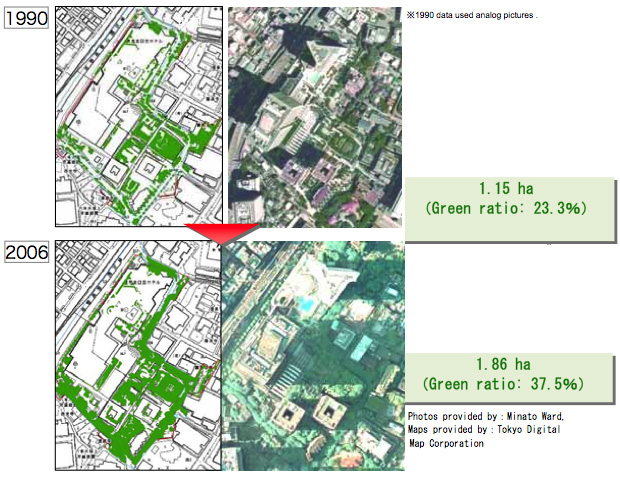
Contributing to the reduction of the urban heat island effect
Pleasant urban environments coexisting with nature not only provide recreational areas but also reduce the urban heat island effect. The thermograms below show the temperatures of areas with green space that is 5℃ to 15℃ lower than the surface temperatures of areas paved with asphalt.
■Green area and green ratio of major Mori Building projects

■Thermograms (Roppongi Hills, ARK Hills, and Atago Green Hills)
Pale blue parts in the thermograms above are areas where temperatures go up to around 30℃, and red parts go over 40℃. It shows the temperatures in areas with green space is 5℃ to 15℃ lower than the surface temperatures of areas paved with asphalt.
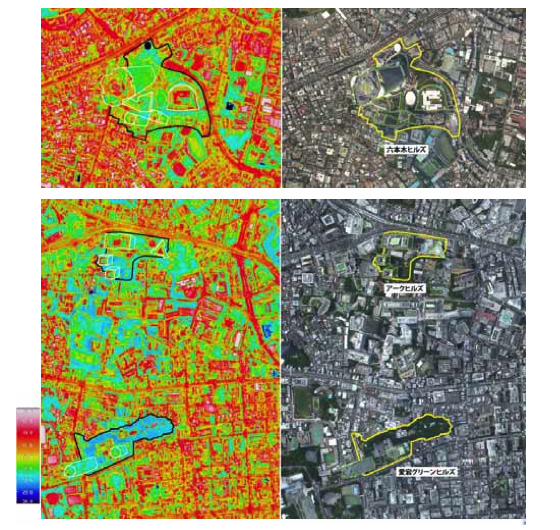
Awarded various environmental prizes. Considering biodiversity for the future
Mori Building's continuous efforts to green urban areas under the "Vertical Garden City" philosophy has been well recognized and earned the "Prize of Minister of Land, Infrastructure and Transport in the 17th Global Environment Awards" as well as many other awards. In the future Mori Building will continue to respond to environmental issues and create landscapes (urban developments) which show the four seasons of Japan and which consider biodiversity for establishing ecological networks in urban areas.
■List of environmental awards received
| Year | Award | Organization |
| FY 2002 | Urban Green Space Award "Minister of Land, Infrastructure and Transportation Award" | Urban Green Space Development Foundation |
| FY 2005 | SEGES (Social and Environmental Green Evaluation System) Urban Green Space Award STAGE3 | Urban Green Space Development Foundation |
| FY 2006 | SEGES (Social and Environmental Green Evaluation System) Urban Green Space Award STAGE3 | Urban Green Space Development Foundation |
| Road Day "Distinguished Service for Roads Director of the Construction Bureau Award" | Ministry of Land, Infrastructure and Transport | |
| Energy Globe Award | Energy Globe (Austria Citizen Group) | |
| FY 2007 | SEGES (Social and Environmental Green Evaluation System) Urban Green Space Award STAGE3 | Urban Green Space Development Foundation |
| Road Day "Distinguished Service for Roads Minister of Land, Infrastructure and Transportation Award | Ministry of Land, Infrastructure and Transport | |
| Prize of Minister of Land, Infrastructure and Transport in Global Environment Awards | Fuji Sankei Group |
(References) Summary of green ratio survey
Measured expansion of greenery by aerial photos Previous surveys calculated green space based on the area of our design where analogical values could be calculated, but not actual plant growth. In this survey, we used digital aerial orthophotos (taken by Minato ward) to calculate the green area with a green-covered diagram by extracting and coloring infrared waves in a specific wavelength region which were reflected by leaves.
Green ratio is a ratio of the green area to the area that the green area belongs to.
